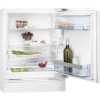AEG Energy Efficient Integrated 59.6cm Refrigerator White SKS58210F0 Product M - Page 8
Periodic cleaning, Defrosting of the, refrigerator, Cleaning the air channels, Periods of non-
 |
View all AEG Energy Efficient Integrated 59.6cm Refrigerator White SKS58210F0 manuals
Add to My Manuals
Save this manual to your list of manuals |
Page 8 highlights
8 www.aeg.com 7.2 Periodic cleaning CAUTION! Do not pull, move or damage any pipes and/or cables inside the cabinet. F P CAUTION! Take care of not to damage the cooling system. CAUTION! When moving the cabinet, lift it by the front edge to avoid scratching the floor. The equipment has to be cleaned regularly: 1. Clean the inside and accessories with lukewarm water and some neutral soap. 2. Regularly check the door seals and wipe clean to ensure they are clean and free from debris. 3. Rinse and dry thoroughly. 4. If accessible, clean the condenser and the compressor at the back of the appliance with a brush. This operation will improve the performance of the appliance and save electricity consumption. 7.3 Defrosting of the refrigerator Frost is automatically eliminated from the evaporator of the refrigerator compartment every time the motor compressor stops, during normal use. The defrost water drains out through a trough into a special container at the back of the appliance, over the motor compressor, where it evaporates. It is important to periodically clean the defrost water drain hole (F) situated under the salad drawers to prevent the water overflowing and dripping onto the food inside. Use the special cleaner provided (P), which you will find already inserted into the drain hole. 7.4 Cleaning the air channels 1. Remove the plinth (A), then the ventilation grid (B). C BA 2. Clean the ventilation grid. (Refer to "Cleaning the ventilation filter ". ) 3. Carefully pull the air deflector out (C), checking that there is no water left from the defrosting. 4. Clean the lower part of the appliance with a vacuum cleaner. 7.5 Periods of non-operation When the appliance is not in use for long periods, take the following precautions: 1. Disconnect the appliance from electricity supply. 2. Remove all food. 3. Leave the door/doors open to prevent unpleasant smells. WARNING! If the cabinet will be kept on, ask somebody to check it once in a while to prevent the food inside from spoiling in case of a power failure.















